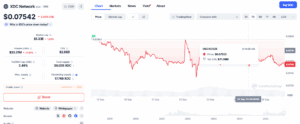XDC Network co-founder Ritesh Kakkad says the tokenization of real-world assets (RWAs) could reach $7 trillion within five years if adoption continues to expand under new U.S. rules. He pointed to the size of traditional markets as the basis for his forecast. Global assets across currencies, real estate, metals, bonds, and stocks are worth about $700 trillion. If even 1% of this shifts to blockchains, Kakkad said, it would equal $7 trillion in tokenized value within the next three to five years.

XDC Co-founder Says U.S. Stablecoin Laws Drive Confidence
Kakkad highlighted stablecoins as the leading trend in the U.S. market. He cited the recent passage of the Genius Act and the Anti-Surveillance of CBDC Act. Together, these form a regulatory framework for stablecoins. The laws require issuers to maintain full reserves in cash or U.S. Treasuries. This gives institutional investors more confidence.
Kakkad pointed to Circle’s listing on the New York Stock Exchange, where its valuation jumped from $30 to $300 per share, as proof of demand. He argued that with regulation in place, stablecoins could serve as the foundation for large-scale RWA settlement and cross-border payments.
Another Wall Street trend Kakkad discussed was the emergence of Digital Asset Treasury Companies (DATCOs). He compared the model to Berkshire Hathaway’s early structure, where the company held long-term investments in traditional stocks like Coca-Cola.
DATCOs, by contrast, hold cryptocurrencies and tokenized assets such as Bitcoin, Ethereum, or XDC. They generate yield by deploying those assets in decentralized finance (DeFi). Kakkad said the model is gaining traction because it allows firms to list on regulated exchanges like Nasdaq while maintaining transparency in financial filings.
Kakkad argued that XDC network is positioned as a strong base layer for tokenization and settlement. He cited three advantages: XDC’s low fees suitable for microtransactions, two-second transaction times for fast settlement, and energy efficiency with 99% lower consumption compared to proof-of-work blockchains.
Kakkad added that XDC’s compliance features, such as KYC-enabled validator nodes and slashing mechanisms to remove bad actors, make it attractive to institutions wary of regulatory risk. Wall Street firms, he said, valued these features more than Bitcoin or Ethereum’s open structures.
At press time, XDC price stands at $0.07, down 1% froma day ago and 5.3% in a week.

Tokenization Market Expands Beyond Crypto
Kakkad linked his $7 trillion projection to the larger adoption curve of tokenization. Global banks process $4 trillion to $20 trillion in daily transactions. This is far more than the crypto sector’s yearly totals. He said that if blockchains capture even a small share of this volume, the market for tokenized assets will expand rapidly.
He also noted the importance of stablecoin integrations, such as Circle’s USDC support for XDC, which enable cross-border settlements in trade finance and payments. With the new U.S. laws in place, he sees a historical moment for blockchain adoption.
Kakkad’s forecast mirrors similar views by Cardano founder Charles Hoskinson, who recently said that up to $10 trillion in assets could move on-chain once U.S. securities laws are clarified. Both see RWAs as the largest growth driver for blockchain over the next five years. Although Kakkad frames the opportunity around Wall Street trends such as stablecoins and DATCOs.
